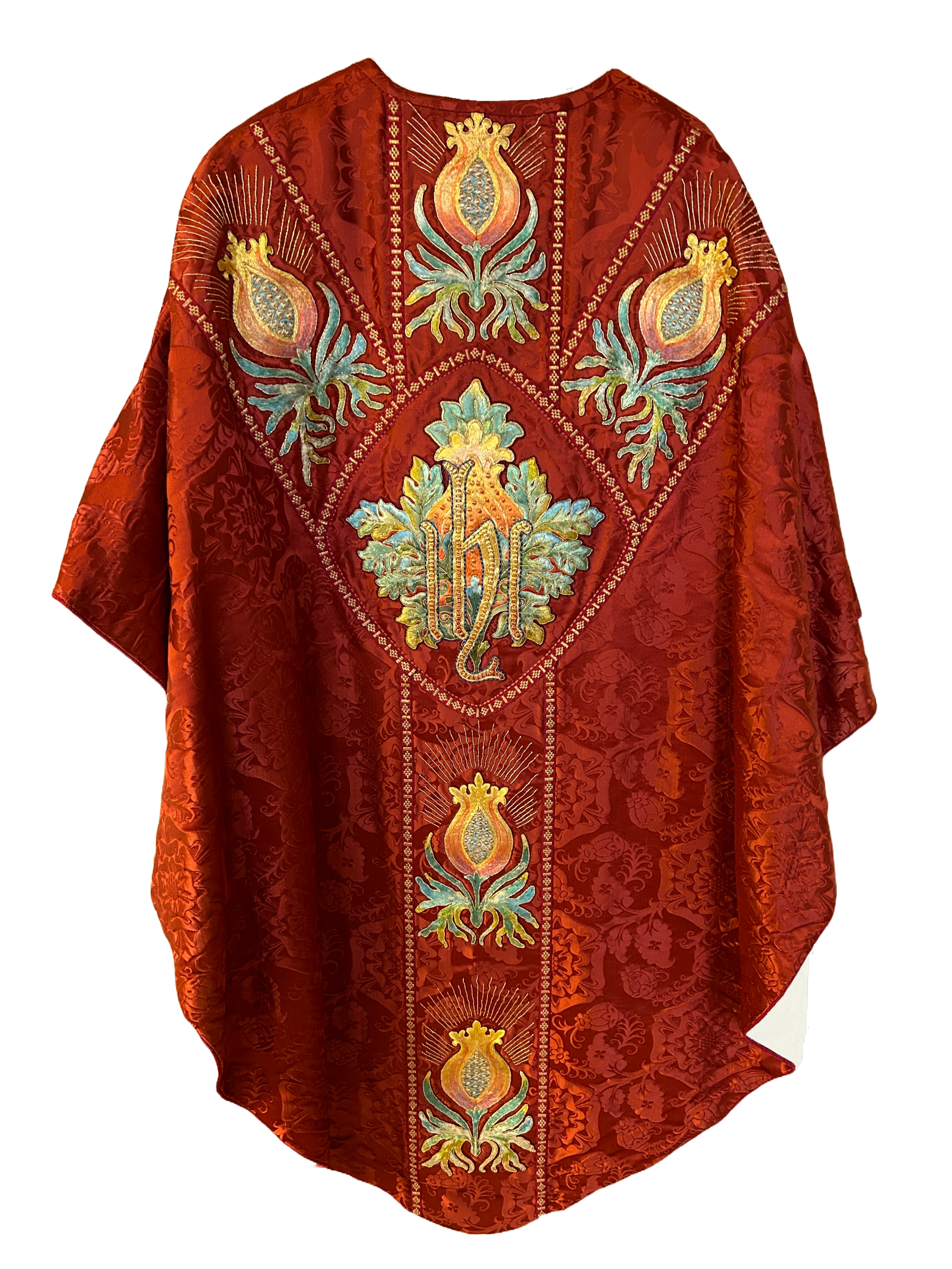Pomegranates, Pelicans and Patterns
Early 20th century silk and metallic gold embroidered pomegranate.
The Community of St. Mary
Several weeks ago I traveled to Greenwich, NY and visited the Community of St. Mary, Eastern Province to continue my research on ecclesiastical textiles in the state of New York. Founded on the Feast of the Purification in 1865 by Harriet Starr Cannon, The Sisterhood of St. Mary was the first Anglican religious order established for women in America. Through perseverance and hard work with the poor and disadvantaged in New York City, the five founding sisters convinced Bishop Horatio Potter to receive them as a Benedictine monastic community. They initially faced fierce opposition but never waivered in their commitment to their vocation and went on to establish houses of mercy, missions, infirmaries, children’s hospitals, schools and orphanages. In addition to their incredible history of service the Sisters also produced masterpieces of ecclesiastical embroidery.
Late 19th century “We Worship with Glory” Angel Frontal.
The Church Workroom, New York City
In 1868 a townhouse at 41 West 46th Street, NYC was selected to be used as a convent and girl’s school and by the 1870’s they were making and selling garments; "For gentlemen's shirts with bosom inserted, $1; night shirts, 44c; sac chemise, 25c." By the 1880’s Sister Anna was teaching classes in fine sewing and enlisting the students to create stunning works of ecclesiastical embroidery. Pictured above is one of the frontals created by Sister Anna and her students and now housed in a custom-built case in the Greenwich convent library. Below is a burse from a Requiem set along with its original patterns drawn by Fr. H. Darby and worked by Sister Anna and used in St. Mary’s School, NYC.
Detail of the Risen Christ Requiem burse embroidered by Sister Anna, CSM. Late 19th century.
Original Risen Christ Requiem set embroidery pattern. Late 19th century.
Risen Christ Requiem burse embroidered with silk and metallic gold thread. The embroidery was conserved and reapplied to new damask fabric. Late 19th century.
Original embroidery pattern showing a detail of the figure of the Risen Christ. Late 19th century.
The Church Workroom, Peekskill, NY
By the late 19th century the Sisters of St. Mary were working in thirteen houses in New York City, Peekskill, Memphis, Kenosha, Chicago and Sewanee. Due to a need to accommodate the care of convalescent and incurable patients from St. Mary's pediatric hospital in Manhattan, the Sisters opened a country home in Peekskill, NY. By October of 1903 the Sisters were able to move into a newly built stone convent up on the hill which could accommodate seventy-five Sisters and helped to consolidate the work of some of the houses. It was during this time in Peekskill when the Church workroom was firmly established as an active part of the Community. In the new convent, Sister Winifred was in charge of the workroom until the 1920’s and many examples of her fine work, original patterns and workroom records survive. She especially loved the image of the Pelican as the personification of Christ giving His life for us represented by the mother pelican piercing her breast to feed her young with her blood.
Chasuble with silk and metallic gold vesica embroidered with a pelican and her young. Designed and worked by Sister Winifred. Early 20th century.
Original pattern for pelican embroidery indicating stitch directions and silk thread colors. Early 20th century.
Detail of pelican vesica embroidery designed and worked by Sister Winifred. Garnets are used to represent blood. Early 20th century.
Tabernacle door panel with the same pelican design as chasuble. Chapel Community of St. Mary. Early 20th century.
The Community of St. Mary, 20th Century to Today
In the 1930’s the running of the Church workroom was taken on by Sister Hilda. Due to the Great Depression and changing fashions, many small embroidery firms were closing. Sister Hilda had the foresight to purchase up all the fine silks, gold thread and supplies which were then used in the workroom well into the 1960’s. What is truly remarkable is that Sister Hilda also kept detailed records of all the vestments made for outside clients or use within the Community. These sturdy oaktag pages have samples of fabrics, notions and threads attached plus on the back or on additional pages are drawn the pattern designs. These records show that the Community made vestments for churches and clergy all across the US, even as far away as Honolulu, Hawaii. In 2004 when the Sisters of St. Mary, Eastern Province moved to their current convent in Greenwich, NY the workroom records, supplies, patterns and vestments were taken with them.
Passiontide chasuble embroidered with pomegranates and the sacred IHC monogram. Early 20th century.
Sample fabric, notions and full descriptive record of the Passiontide set. Dated 1929 - 1931 and noting that in 1936 Sister Hilda made a matching burse and veil.
Detail of Passiontide chasuble embroidery. Early 20th century.
Verso with drawings of the pomegranate embroidery pattern used on the set with notes on thread colors, etc.
Gratitude and Thanks!
I continue to be grateful to the Historical Society of the Episcopal Church for providing me with the financial support that enabled me to visit the Community of St. Mary, Eastern Province. My heartfelt thanks to Mother Miriam, Sister Mary Elizabeth and Sister Catherine Clare (and Lucy the dog!) for welcoming me with such kindness and hospitality. They are the faithful custodians of an extremely important archive of ecclesiastical embroidery patterns, church workroom record books, practice embroideries, finished vestments and materials spanning over 140 years of Community life. I feel that I have only just scratched the surface and cannot wait until I am able to return. Stay tuned…
If you haven’t signed up yet and would like to receive more research updates, click on the link below and join my email list.














